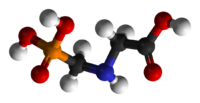
Photo from wikipedia
PHARMACOLOGY RELEVANCE Baccharis trinervis (Lam, Persoon) leaves are used in the traditional medicine for the treatment of high fevers, edema, inflammation, sores and muscle cramps, snakebites and as antiseptic. AIM… Click to show full abstract
PHARMACOLOGY RELEVANCE Baccharis trinervis (Lam, Persoon) leaves are used in the traditional medicine for the treatment of high fevers, edema, inflammation, sores and muscle cramps, snakebites and as antiseptic. AIM OF THE STUDY To investigate the cytotoxic, genotoxic, and mutagenic effects of extracts and fractions of B. trinervis from Brazil and Colombia in Chinese Hamster Ovary (CHO) cells, and to examine the mutagenic activity in Salmonella typhimurium. MATERIAL AND METHODS Aqueous extracts (AE) of aerial parts of B. trinervis from Brazil (B) and Colombia (C) were fractioned in ethyl acetate fraction (EAF), butanol extract (BF), and aqueous residue fraction (ARF). Qualitative chemical screening and determination of total flavonoid content were made. Identification of chemical constituents was performed by High Performance Liquid Chromatography (HPLC) and High Resolution Mass Spectrometry (HRMS). For the in vitro tests, CHO cells were treated for 3h with extracts and fractions. The cytotoxic activity was evaluated by clonal survival and 3-(4.5-dimethylthiazole-2-yl)-2.5-biphenyl tetrazolium bromide reduction assay (MTT). Genotoxic and mutagenic effects were evaluated by the alkaline comet assay and Cytokinesis-blockage micronucleus test (CBMN), respectively. Additionally, Salmonella/microsome assay was carried out to determinate the mutagenic effects in EAF from Brazil and Colombia. RESULTS Phytochemical analyses indicated the presence of saponins and flavonoids. AE and EAF were the samples with the highest quantity of total flavonoids. HPLC showed the presence of luteolin only in AEC, and caffeic acid, ellagic acid, rosmarinic acid, and rutin were identified in AEB and AEC (AEC>AEB). The HRMS in positive mode of EAFB and EAFC showed presence of two carboxylic acids, coumarin, and two terpenoids. In addition, were identified one terpenoid and two carboxylic acids in AE, BF and ARF of B. trinervis from both countries in negative mode. Dose-dependent cytotoxic effects were observed in CHO cells treated with B. trinervis extracts and fractions by using clonal survival and MTT at concentrations higher than 0.05mg/mL. All the extracts and fractions induced DNA strand breaks in CHO cells with dose-dependent response, mostly EAFB and EAFC. The EAF from Brazil and Colombia showed mutagenic effect at 0.5mg/mL, while the other fractions did not show a significant difference in relation to the control. No mutagenic effects were found in EAF from both countries by the Salmonella/microsome assay. CONCLUSIONS Cytotoxic and genotoxic effects were demonstrated in all extracts and fractions used, although only EAF showed mutagenic effects by CBMN, but not by Salmonella/microsome assay. Our results suggest that flavonoids, phenylpropanoids, coumarins, and diterpenes may be responsible for the cytotoxic, genotoxic and mutagenic effects observed.
Journal Title: Journal of ethnopharmacology
Year Published: 2018
Link to full text (if available)
Share on Social Media: Sign Up to like & get
recommendations!